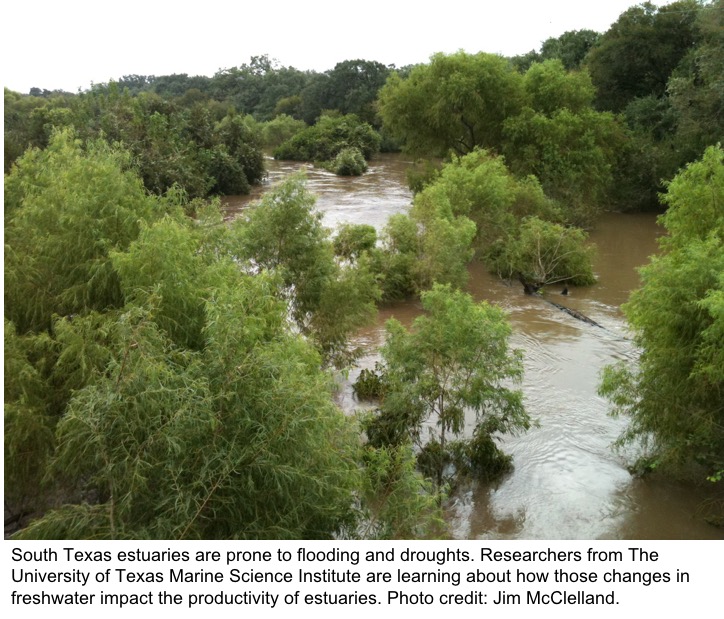There's a saying in Texas that goes "if you don't like the weather, just wait until tomorrow." That adage couldn't be truer for coastal Texas and its estuaries.  The recent hurricane and extreme drought in 2015 are just a few of the drastic swings in weather patterns we've experienced lately. These weather patterns change the amount of freshwater flowing into our estuaries, which change the quantity and quality of nutrients delivered to those estuaries. Those nutrients are the fuel that plankton, shrimp, crabs and fish rely upon. Drastic swings in weather patterns can have an impact on nutrients and the animals that need them. However, very little is known about how nutrients, in the form of particulate organic matter, change during flood and drought conditions.
The recent hurricane and extreme drought in 2015 are just a few of the drastic swings in weather patterns we've experienced lately. These weather patterns change the amount of freshwater flowing into our estuaries, which change the quantity and quality of nutrients delivered to those estuaries. Those nutrients are the fuel that plankton, shrimp, crabs and fish rely upon. Drastic swings in weather patterns can have an impact on nutrients and the animals that need them. However, very little is known about how nutrients, in the form of particulate organic matter, change during flood and drought conditions.
Biogeochemists Drs. Amber Hardison and Zhanfei Liu at The University of Texas Marine Science Institute in Port Aransas are interested in amending the knowledge gap. They were recently awarded $299,993 to learn just what impact floods and droughts have on local Texas estuaries. This was one of the seven projects recently funded by the Texas Sea Grant College Program at Texas A&M University.
"Following a competitive and rigorous peer-review process, we have selected the seven best research projects that will advance knowledge, integrate research and extension, and result in broader impacts that benefit society," said Dr. Pamela T. Plotkin, Director of Texas Sea Grant. "These research investments will generate substantial social, economic and environmental impacts, help develop the workforce and contribute to the sustainability of Texas' natural and built environments."
In South Texas, higher temperatures and drier conditions lead to very low freshwater inflow levels to estuaries for much of the year, often multiple years. These long dry conditions are interspersed with sporadic pulses of rain that flood the estuaries with freshwater and bring with it nutrients, sediment and vegetation. "Our estuaries in South Texas are as unique as the people that live here," said lead researcher Amber Hardison. "With this research we hope to gain a better understanding of how the feast and famine of freshwater shapes the uniqueness of the estuaries and learn the underlying mechanisms for what makes it so."